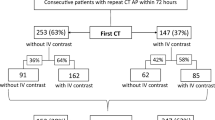Abstract
Computed tomography of the abdomen and/or pelvis (CTAP) is frequently used in the emergency department (ED) allowing diagnosis of a variety of conditions, but requiring a prolonged period of preparation. To determine whether not requiring oral contrast for CTAP reduces ED length of stay (LOS). Retrospective cohort of adult patients visiting an academic ED over 13 weeks around a radiology protocol change. Before the change, many CTAPs required oral contrast; thereafter, oral contrast was not required. LOS was compared before and after the change among all adult ED patients. Among patients undergoing CTAP, adjusted LOS and time to CTAP were compared using multivariate linear regression. 20,464 adult ED visits occurred over the study period, including 1,806 where a CTAP was performed. Oral contrast usage decreased from 42.5% of CTAP to 12.2% (difference 30.3%, 95% confidence interval 38.7% to 46.3%). There was no change in LOS among all ED visits. Among ED visits where a CTAP was performed, median time to CTAP decreased by 27 min and median LOS decreased by 30 min. Adjusted LOS decreased from 324 min (312–337) to 297 min (285–309). Not routinely requiring oral contrast for CTAP in the ED is associated with a half-hour reduction in LOS among all patients undergoing CTAP.
Similar content being viewed by others
References
McCaig LF, Nawar EN (2006) National Hospital Ambulatory Medical Care Survey: 2004 emergency department summary. Advance data from vital and health statistics; no 372. National Center for Health Statistics, Hyattsville, MD
Torbati SS, Guss DA (2003) Impact of helical computed tomography on the outcomes of emergency department patients with suspected appendicitis. Acad Emerg Med 10:823–829
Ahn SH, Mayo-Smith WW, Murphy BL et al (2002) Acute nontraumatic abdominal pain in adult patients: abdominal radiography compared with CT evaluation. Radiology 225:159–164
Rao PM, Rhea JT, Novelline RA et al (1998) Effect of computed tomography of the appendix on treatment of patients and use of hospital resources. N Engl J Med 338:141–146
Rosen MP, Sands DZ, Longmaid HE III et al (2000) Impact of abdominal CT on the management of patients presenting to the emergency department with acute abdominal pain. Am J Roentgenol 174:1391–1396
Brown J, Shesser R (2005) Computed tomography scan use in the emergency department evaluation of patients with nonspecific abdominal pain is increasing despite decreased patient acuity. Acad Emerg Med 12(5 supp):75
Hustey FM, Meldon SW, Banet GA et al (2005) The use of abdominal computed tomography in older ED patients with acute abdominal pain. Am J Emerg Med 23:259–265
Nagurney JT, Brown DFM, Chang Y et al (2003) Use of diagnostic testing in the emergency department for patients presenting with non-traumatic abdominal pain. J Emerg Med 25:363–371
Lee SI, Chew FS (1998) Radiology in the emergency department: technique for quantitative description of use and results. Am J Roentgenol 171:559–564
Rodi SW, Grau MV, Orsini CM (2006) Evaluation of a fast track unit: alignment of resources and demand results in improved satisfaction and decreased length of stay for emergency department patients. Qual Manage Health Care 15:163–170
Asplin BR (2003) Does ambulance diversion matter? Ann Emerg Med 41:477–480
Magid DJ, Asplin BR, Wears RL (2004) The quality gap: searching for the consequences of emergency department crowding. Ann Emerg Med 44:586–588
Schull MJ, Vermeulen M, Slaughter G et al (2004) Emergency department crowding and thrombolysis delays in acute myocardial infarction. Ann Emerg Med 44(6):577–585
Committee on the Future of Emergency Care in the United States Health System (2006) Hospital-based emergency care: at the breaking point. Institute of Medicine, Washington D.C
Rao PN (2004) Imaging for kidney stones. World J Urology 22:323–327
Williams JC Jr, Kim SC, Zarse CA et al (2004) Progress in the use of helical CT for imaging urinary calculi. J Endourology 18:937–941
Miller LA, Shanmuganathan K (2005) Multidetector CT evaluation of abdominal trauma. Radiol Clin North Am 43:1079–1095
Lee S, Coughlin B, Wolfe J et al (2006) Prospective comparison of helical CT of the abdomen and pelvis without and with oral contrast in assessing acute abdominal pain in adult Emergency Department patients. Emerg Rad 12:150–157
Mun S, Ernst R, Chen K et al (2006) Rapid CT diagnosis of acute appendicitis with IV contrast material. Emerg Rad 12:99–102
Huynh LN, Coughlin BF, Wolfe J et al (2004) Patient encounter time intervals in the evaluation of emergency department patients requiring abdominopelvic CT: oral contrast versus no contrast. Emerg Rad 10:310–313
Bland JM, Altman DG (1996) Statistics notes: the use of transformation when comparing two means. BMJ 312:1153
Bland JM, Altman DG (1996) Statistics notes: transformations, means, and confidence intervals. BMJ 312:1079
Kirkpatrick RH, Wittenberg J, Schaffer DL et al (1978) Scanning techniques in computed body tomography. Am J Roentgenol 130:1069–1075
Hamlin DJ, Burgener FA (1981) Positive and negative contrast agents in CT evaluation of the abdomen and pelvis. J Comput Tomogr 5:82–90
Novelline RA, Rhea JT, Rao PM, Stuk JL (1999) Helical CT in emergency radiology. Radiology 213:321–339
Anderson BA, Salem L, Flum DR (2005) A systematic review of whether oral contrast is necessary for the computed tomography diagnosis of appendicitis in adults. Am J Surgery 190:474–478
Robinson WS (1950) Ecological correlations and the behavior of individuals. Am Sociological Rvw 15:351–357
Fuson K (2006) ‘Patient’ says it all. USA Today, May 31, 2006
Author information
Authors and Affiliations
Corresponding author
Additional information
Note: Dr. Schuur was a chief resident at R.I. Hospital, in the Department of Emergency Medicine when this research was initiated (conception of project, IRB approval, data acquisition) but completed this work in his current position. Dr. Chu was a medical student at Brown Medical School when he participated in the research and is now at UCLA.
Rights and permissions
About this article
Cite this article
Schuur, J.D., Chu, G. & Sucov, A. Effect of oral contrast for abdominal computed tomography on emergency department length of stay. Emerg Radiol 17, 267–273 (2010). https://doi.org/10.1007/s10140-009-0847-1
Received:
Accepted:
Published:
Issue Date:
DOI: https://doi.org/10.1007/s10140-009-0847-1




